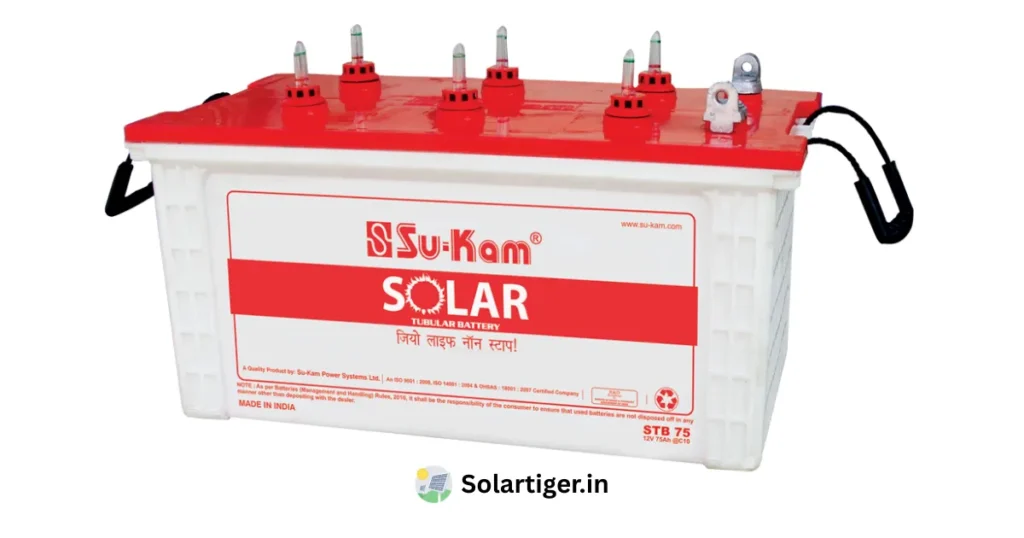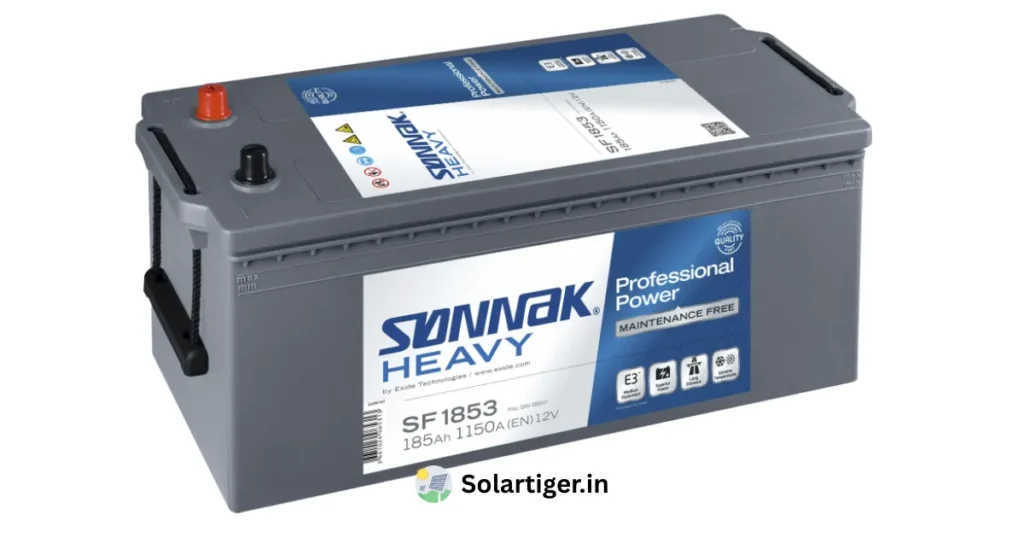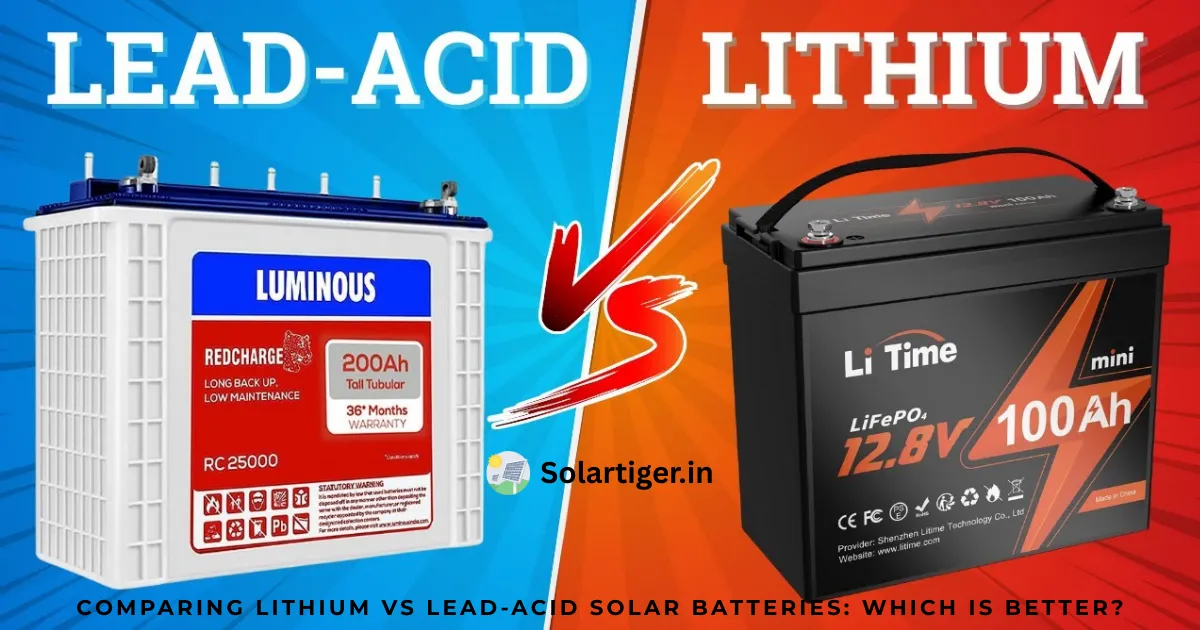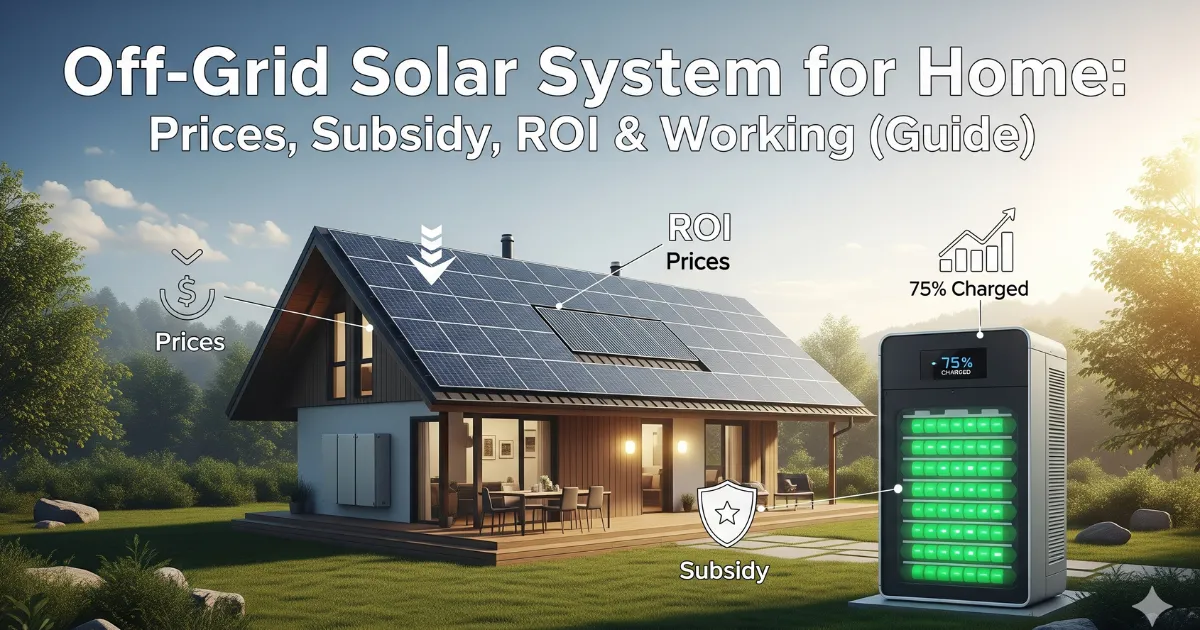With the rapid growth of rooftop solar systems in India, one of the most important decisions for homeowners and businesses is choosing the right solar battery. The battery determines how efficiently you can store energy, how long it lasts, and how much you ultimately save on electricity bills.
Two main types dominate the market: Comparing Lithium vs Lead-Acid Solar Batteries. Both have advantages and drawbacks, and the choice depends on your energy needs, budget, and long-term goals.
In this article, we’ll compare these batteries on cost, efficiency, lifespan, maintenance, and ROI, and share real-life case studies of Indian households and small businesses.
Key Differences Between Lithium vs Lead-Acid Solar Batteries
| Feature | Lithium-ion Battery | Lead-Acid Battery |
|---|---|---|
| Initial Cost | High (~₹1–1.2 lakh for 5kWh) | Low (~₹30,000–₹50,000 for 5kWh) |
| Efficiency | 90–95% | 70–80% |
| Lifespan | 10–15 years | 3–5 years |
| Depth of Discharge (DoD) | 80–95% | 50% recommended |
| Maintenance | Minimal | Requires regular checkups |
| Weight | Light | Heavy |
| Space Required | Less | More |
| Safety | Very safe, with BMS | Safe but prone to acid spills if mishandled |
Cost Comparison of Lithium vs Lead-Acid Solar Batteries (2025 Prices in India)
For a 5kWh battery, which is common for household solar setups:
- Lithium-ion battery: ₹1,00,000 – ₹1,20,000
- Lead-acid battery: ₹35,000 – ₹50,000
At first glance, lead-acid seems more affordable. However, when considering lifespan and efficiency, lithium batteries can provide better value in the long run.
Efficiency and Energy Storage of Lithium vs Lead-Acid
Lithium batteries have higher round-trip efficiency (~90–95%), meaning less energy is lost when charging and discharging.
Lead-acid batteries, in comparison, lose more energy during cycles (efficiency ~70–80%). This means you may need more lead-acid batteries to store the same usable energy.
Example: To get 5kWh usable storage:
- Lithium: 5kWh battery → 4.5–4.8kWh usable
- Lead-acid: 5kWh battery → 3.5–4kWh usable
Maintenance and Lifespan

Lead-acid batteries require regular water top-ups, cleaning of terminals, and careful monitoring of charge cycles. Their lifespan is generally 3–5 years.

Lithium batteries are almost maintenance-free, with a 10–15 year lifespan, making them ideal for long-term installations.
Real-Life ROI Examples
Case Study 1: Home in Bangalore Using Lithium Battery
- System: 3kW solar panels + 5kWh lithium battery
- Initial battery cost: ₹1,10,000
- Energy savings per year: ₹28,000 (monthly ₹2,300)
- Payback period: ~4 years
- Lifespan savings: ₹28,000 × 12 years = ₹3.36 lakh
“Even though lithium was expensive upfront, it paid off after 4 years. The battery still works perfectly after 6 years, with zero maintenance,” says Mr. Ramesh, homeowner.
Case Study 2: Small Shop in Jaipur Using Lead-Acid Battery
- System: 5kW solar + 5kWh lead-acid battery
- Initial battery cost: ₹45,000
- Energy savings per year: ₹28,000
- Battery replacements in 12 years: 3 (at ₹45,000 each → ₹1,35,000 total)
- Net ROI after 12 years: ₹28,000 × 12 – ₹1,35,000 = ₹1.01 lakh
“Lead-acid was cheaper initially, but I spent a lot on replacements and maintenance. Lithium would have been simpler and more cost-effective long-term,” says Mr. Verma, shop owner.
Depth of Discharge and Usable Energy
Depth of Discharge (DoD) indicates how much of the battery’s energy you can safely use without damaging it:
- Lithium: 80–95% → most energy is usable
- Lead-acid: 50% → only half is usable, effectively requiring double the storage capacity to match lithium
This makes lithium more efficient and space-saving, especially for homes with limited rooftop space.
Safety Considerations
- Lithium batteries come with Battery Management Systems (BMS) that prevent overcharging, overheating, or deep discharge.
- Lead-acid batteries are generally safe but can leak acid if mishandled. Proper ventilation is also required as they release hydrogen gas during charging.
Environmental Impact
Lithium batteries are more environmentally friendly in the long run due to longer lifespan and higher efficiency. Lead-acid batteries are recyclable, but frequent replacements generate more waste.
Key Takeaways
- Upfront cost: Lead-acid is cheaper; lithium is more expensive.
- Lifespan: Lithium lasts 10–15 years, lead-acid 3–5 years.
- Efficiency: Lithium batteries provide more usable energy per kWh.
- Maintenance: Lithium is almost maintenance-free; lead-acid requires monitoring.
- ROI: Lithium has higher upfront cost but better long-term savings and lower total cost of ownership.
Which Battery Should You Choose?
- Choose Lithium if:
- You want a long-lasting, low-maintenance system
- Space is limited
- You’re installing solar for 10+ years
- Choose Lead-Acid if:
- Budget is tight upfront
- You can handle maintenance and replacements
- Short-term installation is sufficient
Frequently Asked Questions (FAQs) related to Lithium vs Lead-Acid Solar Batteries
Which solar battery is better lithium or lead-acid?
How much does a lithium solar battery cost in India?
How much does a lead-acid solar battery cost in India?
Which battery type lasts longer?
Lead-acid: 3–5 years
Lithium batteries offer a longer lifespan, reducing replacement costs and hassle.
Do lithium batteries require maintenance?
Conclusion
When comparing lithium vs lead-acid solar batteries, it’s clear that lithium offers better efficiency, longer lifespan, and less hassle, even though the upfront cost is higher.
For households or small businesses looking to maximize ROI, save space, and reduce maintenance, lithium batteries are the superior choice in 2025. Lead-acid batteries still have their place for smaller budgets or temporary setups, but when planning for the long-term, lithium is the smarter investment.
Investing in the right battery ensures your solar system delivers maximum benefits, helping you save money while contributing to a greener planet.




